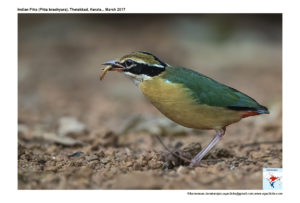
Indian Pitta Pitta brachyuran
Etymology:
- Pitta : Telugu Dravidian name pitta – Pretty, Pet
- Brachyuran : Greek word brakhus-short; ouros-tailed
Vernacular Names :Hindi: Naorang, Pun: Nauranga, Ben: Shumcha, Cachar: Dao buiyegashi, Guj: Navaranga, Hariyo, Mar: Navrang, Ta: Arumanikuruvi, Kathu-alechi, Thottakalla, Te: Polanki pitta, Ponnangi pitta, Mal: Kavi, Kan: Navaranga, Sinh: Avichchiya
Distribution in India: Breeds In Himalayan foot hills to Maharashtra. Winter visitor in peninsular India
Description: Size of 18 cm; wt. of 47–66 g. The adult has top of head as dark buff with black central stripe, white supercilium, broad black band from lores to nape with conspicuous white line beneath eye. The upperparts are dark green, rump is blue, tail is black with dull blue tip, large glossy blue patch on lesser wing-coverts. The flight-feathers are blackish, tipped pale, large white patch on primaries and white tips to inner secondaries. The chin and throat are whitish, rest of underparts are golden buffish except for scarlet belly center and undertail-coverts. The iris is dark brown; bill is black, feet are pinkish. .Both the sexes are alike. The juvenile is duller than adult, little or no pinkish on belly, and orange bill with black near tip.
Habitat: It is found in deciduous and evergreen forest with dense undergrowth in lowland and foothills, as well as scrub and bamboo jungle or sal forest; also found in dried-out riverbeds with grassy banks. It breeds in moist ravines and thick thorny bushes. In non-breeding season it is found in thick forest and secondary jungle, and in gardens or coffee plantations and even town parks. It is found from lowland up to 1800 m in India.
Food Habits: It mainly eats insects and other small invertebrates that they usually pick up from the ground or leaf litter. They have also been noted to take kitchen food scraps from the ground. It forages on ground in manner of a thrush tossing aside leaves, digging with bill in wet soil. It maintains feeding territories in non-breeding areas.
Breeding Habits: They breed during the south-west monsoon from June to August. The nest is shaped like a rugby football, with side entrance, built of twigs, bamboo leaves, grass, moss and fibrous roots, often lined with fine leaves, and placed, above ground in tree, occasionally on ground. The clutch is 4-5 eggs. Both sexes incubate the eggs for about 17 to 19 days. The young fledge in 15 days and are independent in 5 days.